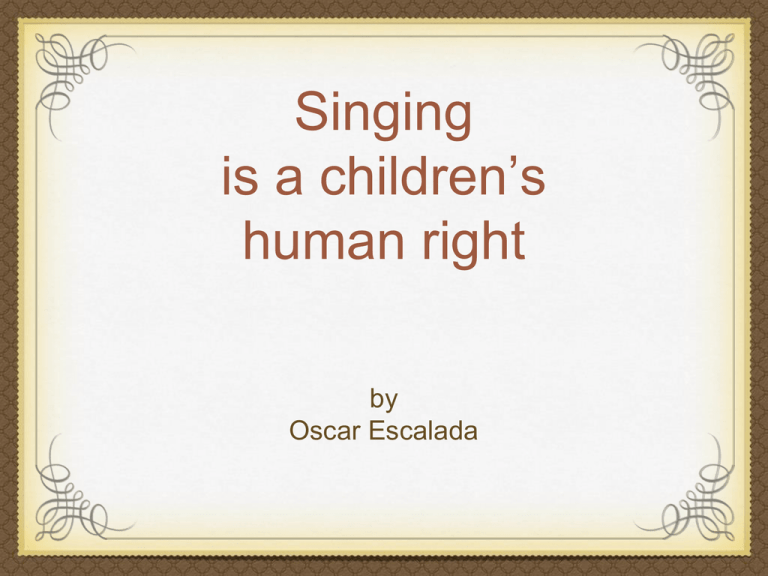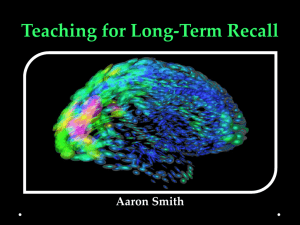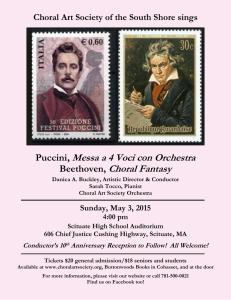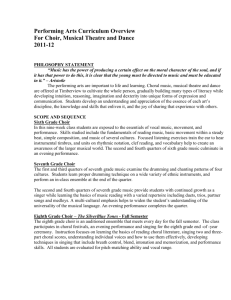the presentation
advertisement

Singing is a children’s human right by Oscar Escalada Human rights Human rights are those “instrumental conditions” that allow the individual his own realization. Universal Declaration of Human Rights, UN, París, September 1948. declaration of the rights of the child • Article 2. • The child shall be given opportunities to enable him to develop physically, mentally, morally, spiritually and socially . UN, 1989 INSTRUMENTAL CONDITIONS AND PERSONAL DEVELOPING Every child that can speak, can sing. What is singing? Singing is to produce vocal sounds with successive changes of heights, dynamic and speed modifications in a musical chain. “...in a musical chain.” • It is referred to esthetic criteria involving historic periods, styles, cultures, schools, etc. Copla de ordeño María Olga Piñeros Colombia Percussion school of Karnataka India Konakkol Style Barbanadir (“Gallop”) Anatoli Kuular Tuva Singer (overtones) Cecilia Bartoli Lascia ch’io pianga (second part) G. F. Händel The skill to reproduce sounds adjusted to pre-stablished heights is what we call TUNNING FACTORS INVOLVED IN TUNNING Psychomotricity TUNNING Audioperception Psychomotricity Orders coming from the brain to the muscles involved in phonation. AudiopercepTiOn Recognition and control of brain stimulation through hearing playback of heights. Dr. Clifford MadsenDirector Music Investigation CenterUniversity of La Florida Tampa He discovered a hearing loss of sounds coming out from his mother’s language in children of six month of age. This research shows the selective capacity in child’s audition. The child imitates for learning. The child takes his mother's speech inflections of her language and region. To express ourselves in speaking we use tones, it depends on how they are used, maintain the tension of the sentence (arsis) or its conclusion (thesis). The range between both ways of speaking can be measured Example: Cada comarca en la tierra tiene un rasgo prominente. (Each region on Earth has a prominent characteristic) Tessitura: Cada comarca en la tierra tiene un rasgo prominente. Investigation CONICET Prof. María Gabriela Mónaco University of La Plata. Children’s ranges Singing voice Minor sixth Speaking voice Major seventh ROUTE OF SPOKEN WORD Motor cortex (gives the order) Brocca’s area (processes) Wernicke’s area (decodes) Auditive cortex (receives the information) Route of the spoken word This would be the same route that uses the production of tones, ie singing. (Dres. Wong & others) AMUSIA But... AMUSIA (Tone deafness) (From the Greek "a", deprivation, and "mousa" music). Disorder of musical capability. It is a tonal congenital deafness. Dr. Jordi Peña-Casanova Neurología de la conducta y neuropsicología (2007) “...of the same nature as aphasia and coinciding with it.” Afasia: Loss of the ability of speak Dres. Psyche Loui, David Alsop and Gottfried Schlaug Harvard University Tone deafness: a new disconnection syndrome? The Journal of Neuroscience August 2009 Arcuate fasciculus Result: Individuals are born without the ability to repeat tones. But... Neuroplasticity Definition Neuroplasticity allows the neurons in the brain to compensate for injury and disease and to adjust their activities in response to new The brain's abilityor toto reorganize itself byenvironment. forming new neural situations changes in their connections throughout life. Neuroplasticity According to Canadian psychiatrist Norman Doidge, neuroplasticity "is one of the greatest discoveries of the twentieth century." Neuroplasticity Magazine of the Association of Physicians of India September, 2012 Localizationism to Neuroplasticity---The Evolution of Metaphysical Neuroscience Sourya Acharya, Samarth Shukla, SN Mahajan, SK Diwan Localizationism: Brocca: “One function, one localization” Neuroplasticity Neuroplasticity (or cortical re-mapping) is the changing of neurons, organization of their networks and their function via new experiences. Neuroplasticity The brain has mechanisms of auto-restoration. If an area in the retina is injured produces a region without response. Immediately adjacent neurons stimulate to the injured area recovering partially or completely lost function. Neuroplasticity As well as a rehabilitation in which there is partial or total loss of traction, you can develop in the individual alternative avenues to wholly or partially reverse the pathology by exercising and a proper plan of cartesian work: go from the simple to the complex. Therefore... Every child that can speak... Can sing! Mirror Neurons Neurons that allows the individual to instinctively and immediately understand what other people are experiencing. This discovery has radically altered the way we think about our brains and ourselves, particularly our social selves. You see a stranger stub her toe and you immediately flinch in sympathy, or you notice a friend wrinkle up his face in disgust while tasting some food and suddenly your own stomach recoils at the thought of eating. Mirror Neurons Choral activity may be helpful for those children as it may develop a certain degree of emotional sustain, belonging feelings and acceptation of what they do giving them socially sensitive environments. The common situation of those children were that they had alcoholic parents offering them a violent environment and at the age of 7 they left their homes. Researchers seriously believe that this neurons are the basis of communication and empathy. But if you don’t develop them, they will disappear at early age. Researchers focussed on the lack of this neurons as the reason why some cases of children’s killed by other children in Liverpool, Great Britain in 1993 and in Maldonado, Uruguay in 2009 continued playing after the murder without any remorse of what they did to their friends. Experts’ opinion Friedrich Nietzsche (Germany,1844-1900) “Without music, life would be a mistake” Dimitri Kabalevsky (Russia,1904-1987) Music and Education (1988) “...every class should be a choir.” Doreen Rao (Canada) We will sing! (1993) “Every child has a natural ability for music” Choral singing is a social, sensitive and supportive activity. Conference of early education and develop of human brain Declaration of Chile - March 2007 "Children, like all people, are fundamentally social beings who learn more effectively in socially sensitive environments and have a responsive capacity via their interactions with responsible adults and other children." Enhances learning Survey conducted by Harris Interactive 2007 Schools with music programs (and choral activities) graduation rate 90,2 %. Schools without music programs (nor choral activities) graduation rate 72,9 % People earning $ 150.000 per year in USA, 83 % had music programs Enhances learning The College Board has found that students involved in music scored 63 percent higher on the verbal section and 44 percent higher on the math section of the SAT than those with no music participation. The SAT is a standardized test for most college admissions in the United States. The SAT is owned, published, and developed by the College Board, a private, nonprofit organization in the United States. In 2009, the College Board reported that students who took four years of music classes scored, on average, 91 points higher on the SAT than students who didn’t. Musical training, to speak and to read. Drs. Wong; Skoe; Russo; Dees y Kraus Northwestern University 2007 The alterations of the brain in the multisensory process of musical training, uses the same connections as those needed to speak and to read. Influence on drug addiction tendency • • Researchers found that drug addiction has 70 % less addicts in individuals with choral activities than in those who have not. The Minnesota Teen Challenge Institute has daily choral activity in order to rescue young people and adults from drugs and alcohol. Choir: Team or family? Dr. Mary Alice Stollak and Dr. Gary Stollak Choral Journal 1991 It works as a team but it is a family 1) Non competitive 2) Supports affectively 3) Develops a degree of membership Who sings scares away his woes Why singing is good? It is a social, sensitive and supportive activity It stimulates the individual effort to obtain a common goal It is a non competitive activity in itself Enhances learning It influences on the drug addiction tendency Mirror neurons involved in the empathy may be enhanced in its development through choral activity. TO PLAY Jean Piaget: recognized the value of playing as the way by which children achieve their goals. Freedom can only be achieved through knowledge Therefore Take out of your mind the idea that a child cannot sing As John Lennon said... ...I hope some day you’ll join us Take out of your mind the idea that a child cannot sing and the world will be as one. MUCHAS GRACIAS Contact www.oescalada.com.ar escalada@isis.unlp.edu.ar





